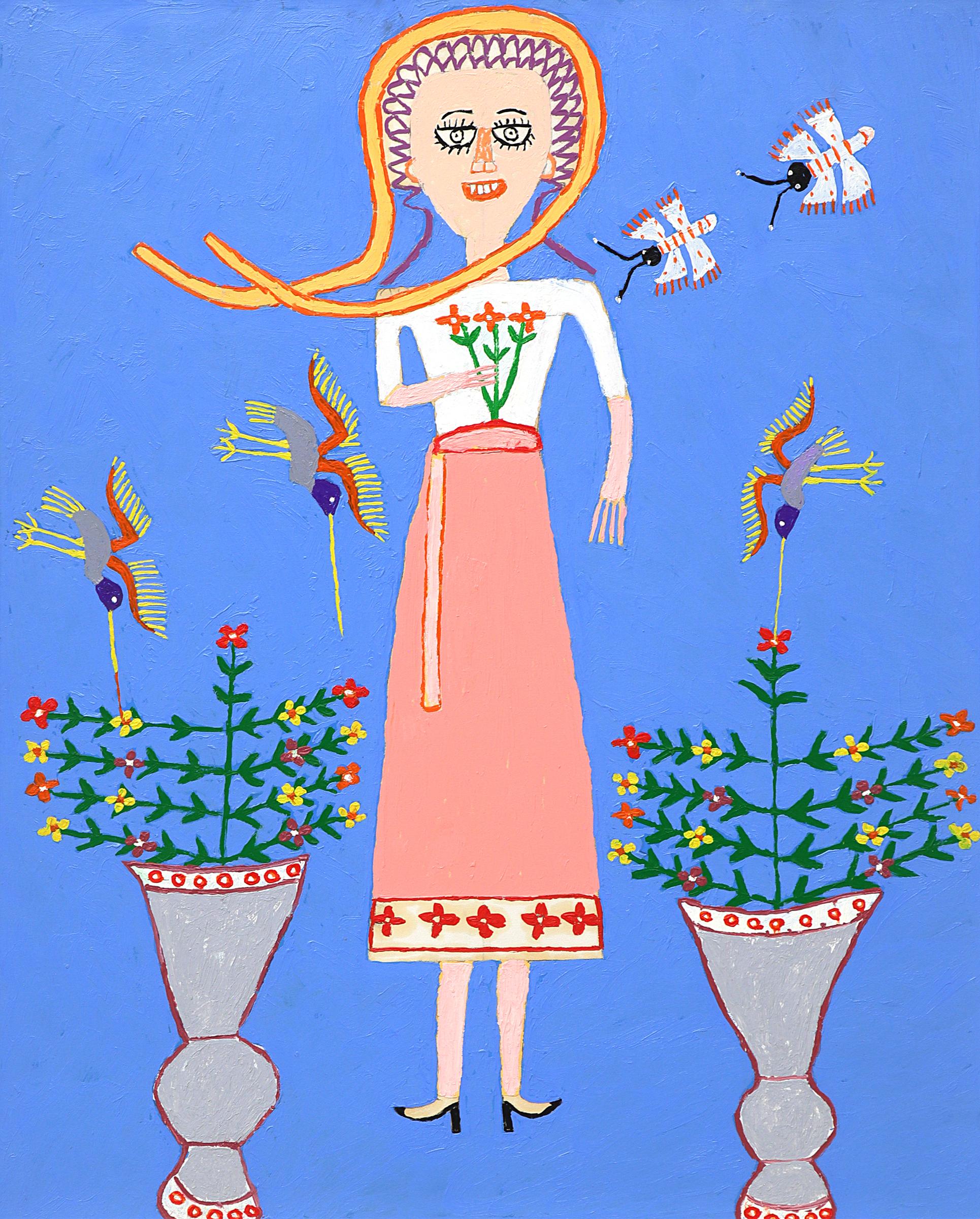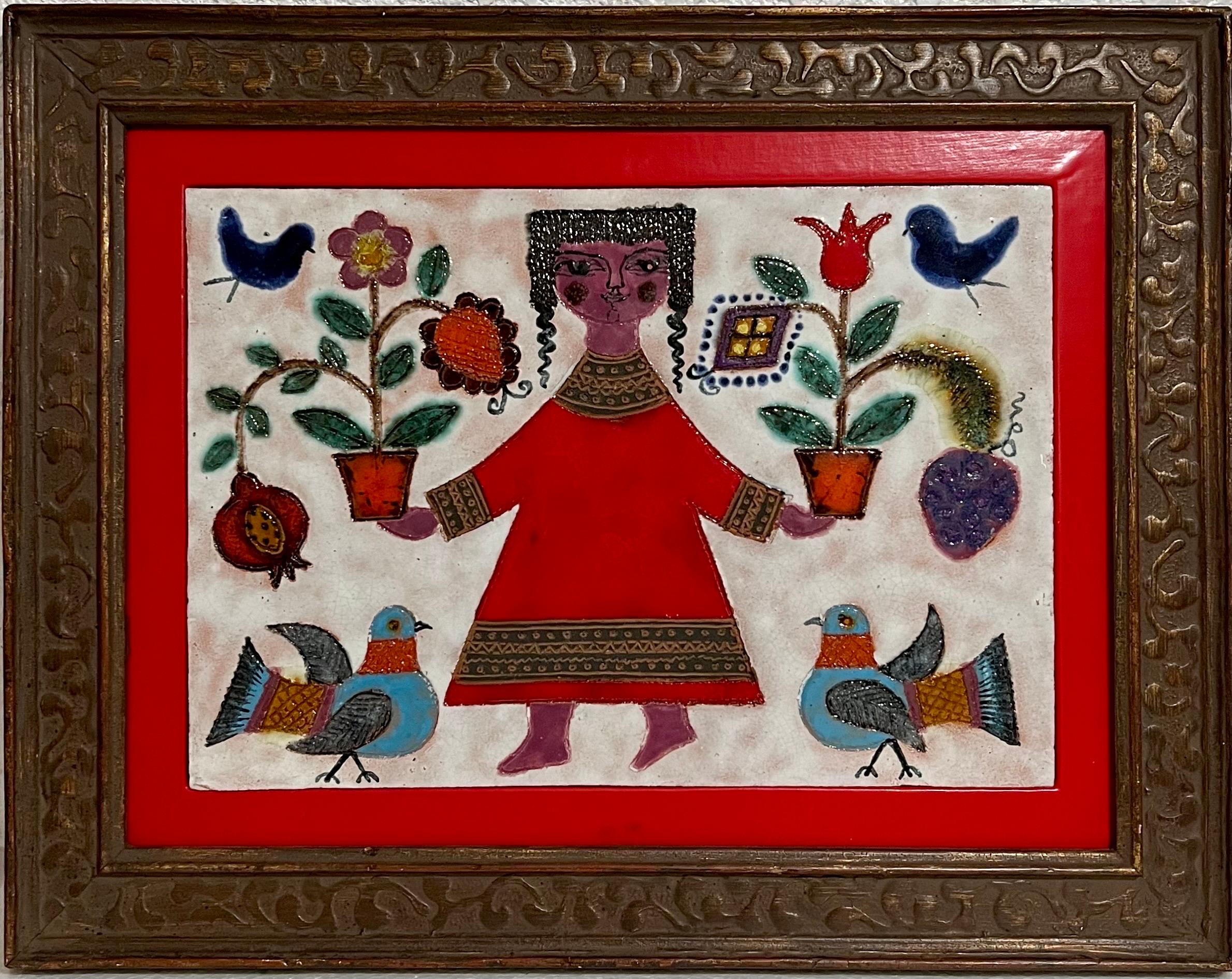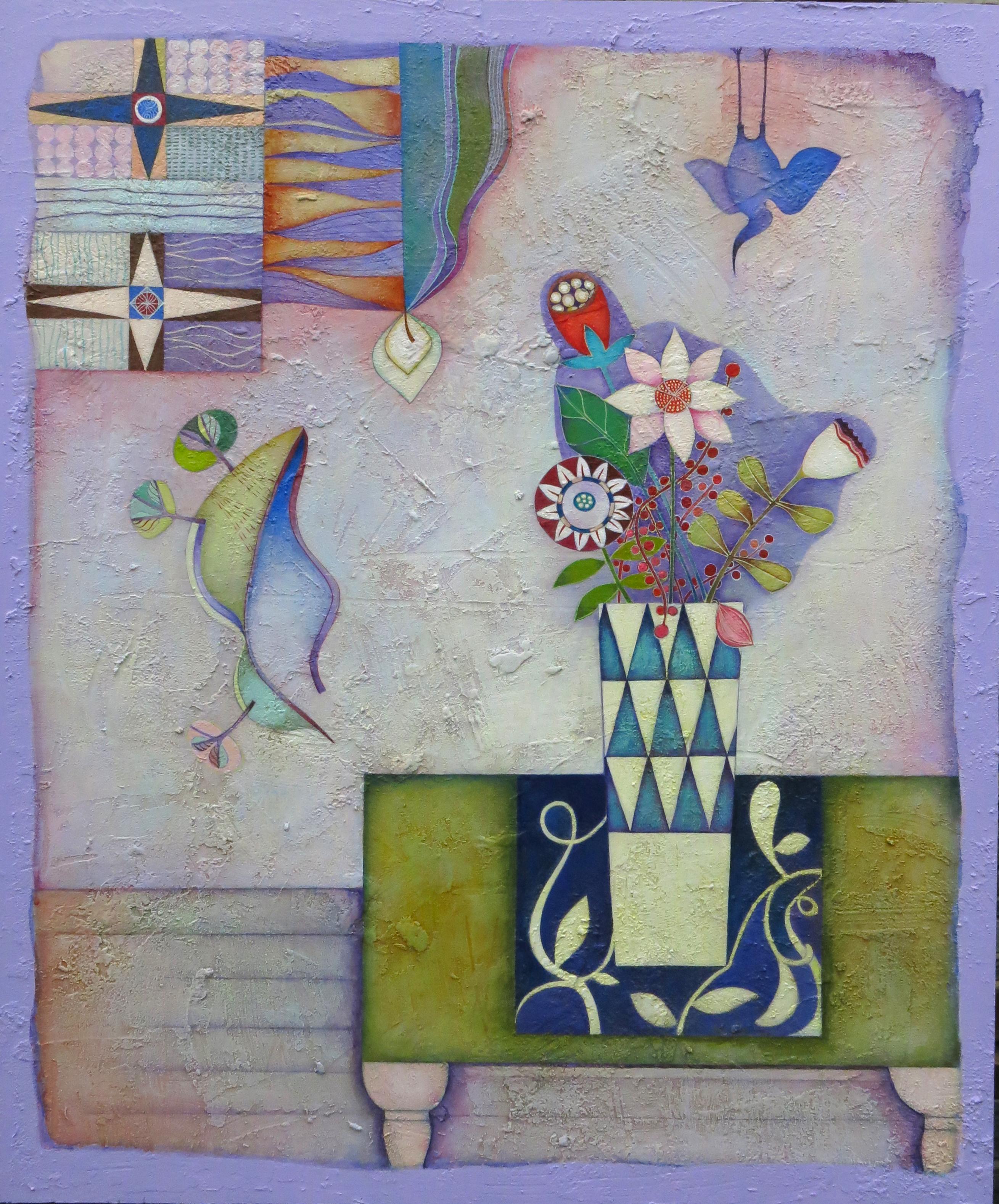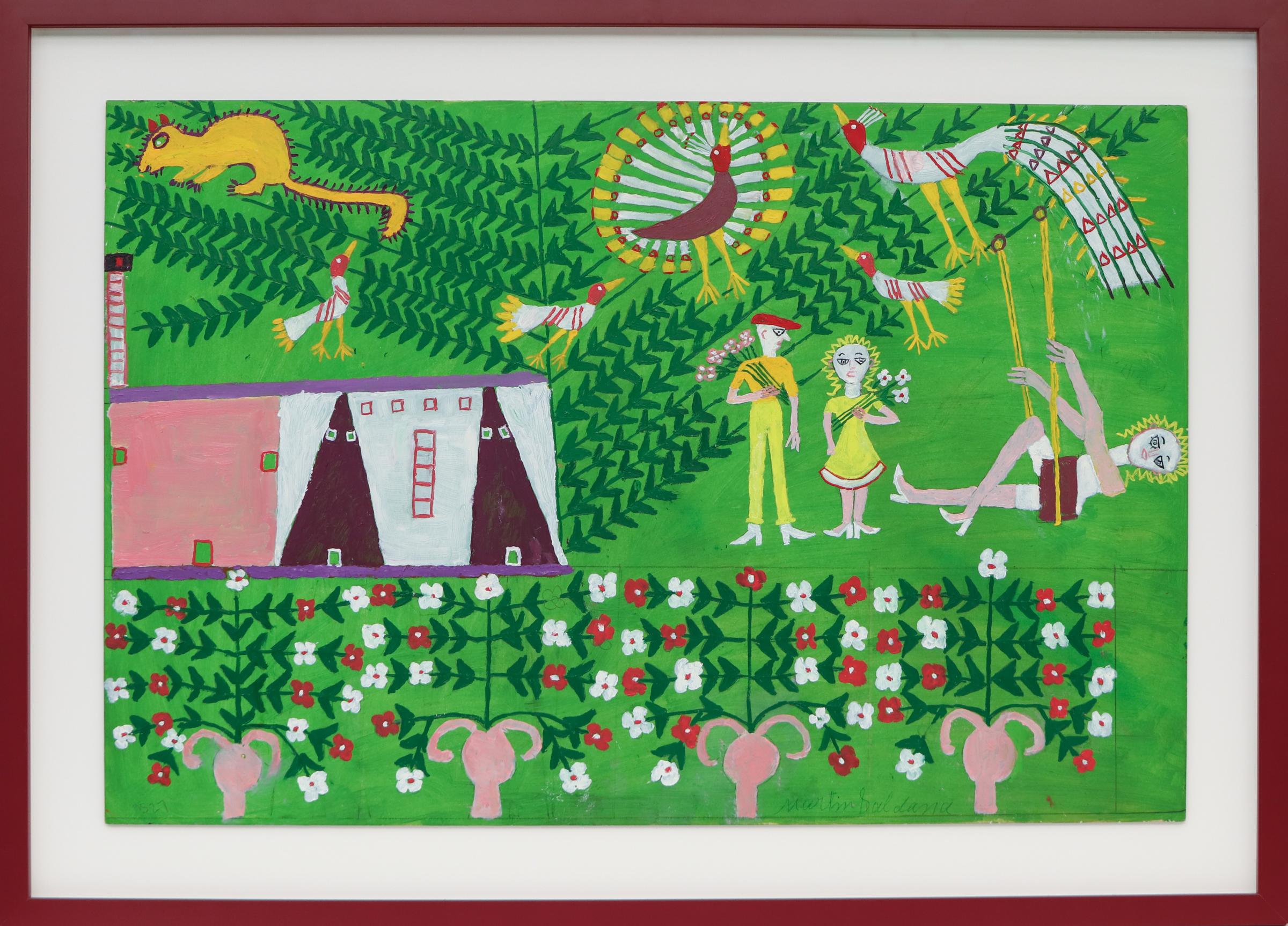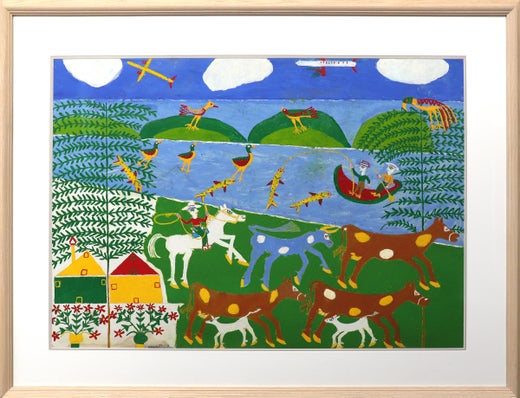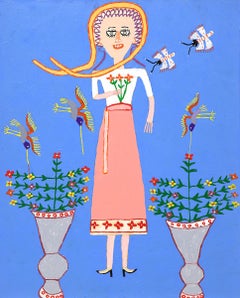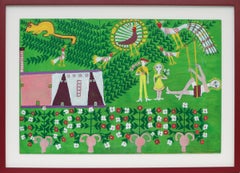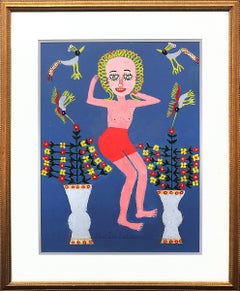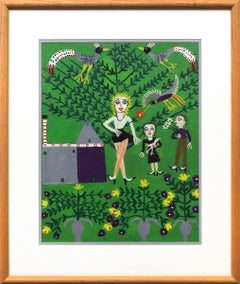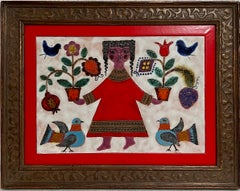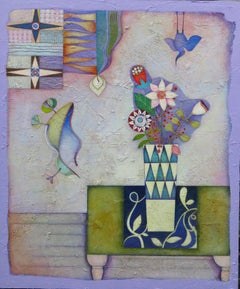Items Similar to Original Naïve Folk Art Oil Painting by Martin Saldaña – Whimsical Girl, Flowers
Want more images or videos?
Request additional images or videos from the seller
1 of 12
Martin SaldanaOriginal Naïve Folk Art Oil Painting by Martin Saldaña – Whimsical Girl, Flowers1953-1965
1953-1965
$3,000
£2,276.33
€2,602.78
CA$4,190.19
A$4,658.92
CHF 2,432.63
MX$56,710.37
NOK 31,039.29
SEK 29,082.33
DKK 19,425.03
Shipping
Retrieving quote...The 1stDibs Promise:
Authenticity Guarantee,
Money-Back Guarantee,
24-Hour Cancellation
About the Item
This enchanting original oil painting, Pinky, is a beautiful example of whimsical Naïve folk art by the artist Martin Saldaña. The artwork features a charming portrait of a young girl surrounded by vibrant flowers, butterflies, and hummingbirds, all brought to life in a playful palette of blue, pink, white, green, purple, and gray. With bold, expressive colors and simple, stylized forms, Saldaña’s painting radiates joy, innocence, and a sense of wonder, capturing a timeless, captivating energy.
Painted on artist board and framed with archival materials for long-lasting preservation, the framed dimensions of this oil painting are 32 x 26 x 1 inches, while the image itself measures 26 x 19 ¾ inches. Its substantial size makes it an eye-catching addition to any art collection or home décor.
About the Artist: Martin Saldaña (1874-1966)
Born in Rancho Nuevo, Mexico, Martin Saldaña led a colorful and adventurous life that deeply influenced his art. After traveling across the U.S. and Mexico and working various jobs, Saldaña discovered his passion for painting at the age of 76, taking a children’s watercolor class at the Denver Art Museum in 1950. Under the guidance of his mentor, artist Lester Bridaham, he spent the final 15 years of his life creating art that reflected his childhood experiences on a family ranch and his profound connection to nature.
Saldaña’s works are known for their bold use of color, geometric shapes, and symbolic imagery, blending his Mexican heritage with his love of the natural world. His paintings, often depicting flowers, animals, and everyday life, are held in prestigious collections such as the Denver Art Museum, the University of Wyoming Art Museum, and the Stedelijk Museum in Amsterdam.
This one-of-a-kind Pinky oil painting is a rare gem for collectors of folk art, Naïve painting, and visionary works. Its vibrant colors and rich symbolism showcase Saldaña’s unique artistic vision and late-blooming creativity. It’s a perfect addition to any collection, bringing warmth and meaning to the space.
With its captivating style and joyful energy, Pinky is sure to make a beautiful addition to any space, infusing the space with color, life, and a sense of wonder.
- Creator:Martin Saldana (1874 - 1965, Mexican)
- Creation Year:1953-1965
- Dimensions:Height: 32 in (81.28 cm)Width: 26 in (66.04 cm)Depth: 1 in (2.54 cm)
- Medium:
- Movement & Style:
- Period:
- Framing:Frame IncludedFraming Options Available
- Condition:very good vintage condition, detailed condition report available upon request.
- Gallery Location:Denver, CO
- Reference Number:Seller: 261171stDibs: LU27315528612
Martin Saldana
Born in 1874, Saldaña grew up at Rancho Neuvo in Mexico. In 1950, at the age of 76, he began attending children's art classes at the Denver Art Museum. For the next fitfteen years, Saldaña Imaginatively documented whimsical memories from his childhood in San Luis Potosi, Mexico, portraying ranch life, landscapes, and his great love of animals. The prolific artist painted every day, completing a new piece about every three days and amassing an impressive body of work for the former cook at the Denver landmark, the Brown Palace Hotel. Saldaña’s vibrant palette and geometric figures are reminiscent of the tapestries of his Mexican heritage and the paintings, primarily in oil, are innocent and endearing. Saldaña is considered to be a outsider artist, a folk artist who is self-taught, whose work is simple, direct, and high personal. Works Held: Denver Art Museum, University of Wyoming Art Museum, The Colorado Springs Fine Art Center, International Folk Art Museum, Neuss In Aberthor Museum, Stedelijk Museum ©David Cook Galleries, LLC
About the Seller
5.0
Gold Seller
Premium sellers maintaining a 4.3+ rating and 24-hour response times
Established in 1979
1stDibs seller since 2013
291 sales on 1stDibs
Typical response time: 13 hours
- ShippingRetrieving quote...Shipping from: Denver, CO
- Return Policy
Authenticity Guarantee
In the unlikely event there’s an issue with an item’s authenticity, contact us within 1 year for a full refund. DetailsMoney-Back Guarantee
If your item is not as described, is damaged in transit, or does not arrive, contact us within 7 days for a full refund. Details24-Hour Cancellation
You have a 24-hour grace period in which to reconsider your purchase, with no questions asked.Vetted Professional Sellers
Our world-class sellers must adhere to strict standards for service and quality, maintaining the integrity of our listings.Price-Match Guarantee
If you find that a seller listed the same item for a lower price elsewhere, we’ll match it.Trusted Global Delivery
Our best-in-class carrier network provides specialized shipping options worldwide, including custom delivery.More From This Seller
View AllLovely Gal, 1950s Semi-Abstract Figurative Folk Art Oil Painting, & Birds
By Martin Saldana
Located in Denver, CO
"Lovely Gal" is a charming oil on board painting by Martin Saldaña (1874-1965), a self-taught outsider artist known for his vibrant, whimsical depictions of childhood memories and rural life. This semi-abstract figurative work features a colorful palette of bold hues, with flowers and birds that reflect Saldaña's deep connection to nature and his Mexican heritage. The painting is presented in a custom frame with outer dimensions of 30 ¾ x 25 ⅜ x 1 ⅝ inches, and the image size is 24 ½ x 19 ⅛ inches.
About the Artist:
Martin Saldaña was born in 1874 at Rancho Neuvo, Mexico, and led a modest life, working as a cook at Denver's iconic Brown Palace Hotel. At the age of 76, Saldaña began attending children’s art classes at the Denver Art Museum, sparking a late-blooming artistic career. Over the next 15 years, he vividly captured memories of his childhood in San Luis Potosi, Mexico, focusing on ranch life, landscapes, and his love for animals.
Saldaña's work is noted for its bold, geometric figures and vibrant colors, often evoking the influence of Mexican tapestries. His paintings are considered to be naïve and folk art, characterized by their simple, direct, and highly personal style. Saldaña's prolific output—creating a new painting nearly every three days—resulted in an impressive collection of artworks that continue to be celebrated today.
Saldaña’s endearing style continues to captivate art enthusiasts, offering a glimpse into a rich, nostalgic world filled with vibrant colors and heartfelt simplicity.
©David Cook Galleries...
Category
20th Century Folk Art Figurative Paintings
Materials
Oil
1960s Mexican-American Folk Art Oil Painting, Girl on Swing, Birds, Bright Color
By Martin Saldana
Located in Denver, CO
This vibrant 1950s-1960s oil painting by renowned Mexican-American folk artist Martin Saldaña (1874–1965) depicts a whimsical outdoor scene with a young girl on a swing, accompanied ...
Category
Mid-20th Century Folk Art Landscape Paintings
Materials
Oil
Colorful Mid-Century Folk Art Oil Painting by Martin Saldaña, "Small Nude", 1960
By Martin Saldana
Located in Denver, CO
"Small Nude" is a vibrant, semi-abstract oil painting by Mexican-American artist Martin Saldaña (1874–1965). This whimsical mid-century work features a stylized female nude surrounde...
Category
Mid-20th Century Folk Art Figurative Paintings
Materials
Oil
Seated Girl and Hummingbird, Vibrant Figurative Oil Folk Art Painting in Green
By Martin Saldana
Located in Denver, CO
"Seated Girl and Hummingbird" is a vibrant oil on board painting by Mexican artist Martin Saldaña (1874-1965). This captivating folk art piece portrays three figures standing near a ...
Category
Early 20th Century Folk Art Figurative Paintings
Materials
Oil
Vibrant 20th Century Folk Art Oil Painting of Girl, Sheep & Car in Landscape
By Martin Saldana
Located in Denver, CO
"Girl with Sheep and Car" is a captivating mid-20th century oil on board painting by self-taught folk artist Martin Saldaña (1874-1965). This vibrant landscape features a whimsical F...
Category
Mid-20th Century Folk Art Landscape Paintings
Materials
Oil
Mexican American Folk Art Oil Painting – Figures, Houses & Landscape, 20th C.
By Martin Saldana
Located in Denver, CO
A charming and colorful oil on board painting by acclaimed Mexican American folk artist Martin Saldaña (1874–1965), titled “Farm and Figures.” This unique 20th-century outsider artwo...
Category
Mid-20th Century Folk Art Figurative Paintings
Materials
Oil
You May Also Like
Women with Flowers, Folk Art Acrylic Painting by Ernani Silva
Located in Long Island City, NY
Ernani Silva, Brazilian - Women with Flowers, Medium: Acrylic, Collage and Enamel on board, signed in marker, Size: 9.25 x 27.5 in. (23.5 x 69.85 cm)
Category
1990s Folk Art Figurative Paintings
Materials
Enamel
Woman with Flowers, Watercolor Folk Art by Jovan Obican
By Jovan Obican
Located in Long Island City, NY
Woman with Flowers
Jovan Obican
French/Yugoslavian (1918–1986)
Date: circa 1980
Watercolor on Paper
Size: 27.5 x 19 in. (69.85 x 48.26 cm)
Frame Size: 30.5 x 22.5 inches
Category
1980s Folk Art Drawings and Watercolor Paintings
Materials
Watercolor
Girl & Plants Enamel Glazed Ceramic Plaque Israeli Artist Awret Naive Folk Art
By Irene Awret
Located in Surfside, FL
This is a rare ceramic plaque painted with enamel glaze by famed Israeli German artist Irene Awret (these are generally hand signed Awret Safed on the verso. I just have not opened the frame to check) the actual glazed ceramic is 10.25 X 14.75 inches.
It depicts a girl or woman with potted plants, birds, pomegranates and other fruits and flowers in a naif, folk art style.
Irène Awret was born to a Jewish family in Berlin called Spicker, the youngest of three children. Her mother died in 1927, when Irène was six years old. In 1937 she was forced to stop high school, due to the Nazi race laws. Because she could not continue her regular studies, her father sent her to study drawing, painting and art restoration with a Jewish painter. Among his students were a large number of German Jews who knew they would have to leave Germany within a short time and would require a profession to enable them to support themselves.
When the situation grew worse, following the Kristallnacht (the first major attack on German and Austrian Jews in November 1938), her uncle decided to move to Belgium. In 1939 the situation became even worse - her father was fired from his job and the family were forced to leave their home. As a result, Awret's father tried to send her and her sister to Belgium, with the help of smugglers. The first smuggler proved to be a double agent and they were sent back from Aachen to Berlin. Two weeks later they made a second, successful, attempt to sneak across the border.
Awret worked for a Dutch Jewish family as a maid. As she had her room and board there, she was able to save enough money to study art part-time at Brussels' Académie Royal des Beaux-Arts. A few months later Awret's father joined her and her financial situation became easier. She left her job and studied full-time, helping support herself with restoration work when it was available and by painting portraits to order.
Later, Awret found a hiding place on a farm in Waterloo with a Jewish family who were connected with the underground. In January 1943 she had to return to Brussels, living with a false identity card which stated she was a married woman with two children. Awret succeeded in renting an attic without informing the police where she was - she told her landlady that she had been forced to flee her husband because he beat her. While there, she supported herself by restoring wooden sculptures.
A Jewish informer gave her up to the Gestapo, accompanying the two Gestapo men who arrested her. Awret was able to take a bag containing food and drawing materials. She was detained in the Gestapo cellars in Brussels where she drew. Because there was nothing there to draw, she sketched her own hand (view this work). Awret was interrogated in order to reveal the hiding place of her father who was still in Brussels. The National Socialist regime was determined to persecute him, even though he had fought for Germany in World War I and been permanently disabled. They stepped up their torture and brought Awret before Hartmann, the head of the Gestapo in Brussels. When Hartmann saw her block of drawings, he asked her where she had studied art and halted the interrogation.
Awret was placed in a narrow cell and then transferred to Malines camp, which the Belgian's called Mechelen. Malines was a transit camp to Auschwitz, regularly sending 2000 people at a time. Although she arrived just before Transport No. 20, Irène Awret avoided being included. Instead she was put to work in the leather workshop, decorating broaches. While she was there, Hartmann visited the camp and spotted her: "I could have discovered where your father is hiding," he told her. When her artistic talents became known, she was transferred to the Mahlerstube (artist's workshop) where she worked producing graphics for the Germans until the end of the war. When Carol (Karel) Deutsch (whose works are now on view at Yad Vashem) was sent from Mechelen to his death with his wife, he left young Irene his paintbox. Irene also recalls seeing the great painter Felix Nussbaum and his wife being pushed into a boxcar bound for the gas, and tells of the aftermath of the famous 20th Train incident, when a young Jewish doctor armed only with a pistol and helped by two unarmed friends with a lantern ambushed one of Mechelen's Auschwitz-bound trains carrying 1,618 Jews, most of whom had fled Eastern Europe for Belgium.
Awret's job enabled her to paint and draw - mainly in pencil, but also in watercolors and oils. In the artists' workshop she met a Jewish refugee from Poland - Azriel Awret - who would later become her husband. Among the other artists in the workshop were Herbert von Ledermann-Vütemberg, a sculptor from an aristocratic family with Jewish roots, Léon Landau, and Smilowitz, who perished in the camps in the East. Irène and Azriel tried to bribe a German officer to prevent Smilowitz's deportation. Not only were they unsuccessful, but they were almost put onto the same train. Jacques Ochs was another artist with whom they became friends in the camp. Ochs, a French-born Protestant who lived in Belgium, was interned as a political prisoner. He remained in Belgium after liberation.
After the war the Awrets immigrated to Israel and made their home in Safed. They continued to work, and were instrumental in founding Safed's artists' quarter.
The Beit Lohamei Haghetaot (Ghetto Fighters' House Museum) art collection holds works donated by Awret. These date from her time in Malines camp and from her stay in Brussels after the war, when she was in the company of orphans who had hidden while their parents were sent to Auschwitz. Her highly expressive works have made their way to exhibitions at theTel Aviv Museum, the Haifa Museum of Modern Art and the Modern Art Gallery in Washington, D.C., as well as into the private collections of such individuals as Dr. Jonas Salk...
Category
1950s Expressionist Figurative Paintings
Materials
Enamel
This time I put flowers. Raquel Fariñas Symbolic Colorful Folk Art Still-life
By Raquel Fariñas
Located in Segovia, ES
"This time I put flowers" (Esta vez puse flores), Acrylic and mixed media on wood panel, 75x60 cm.
The pictures of Raquel Fariñas are presented before our eyes with an almost naive ...
Category
2010s Folk Art Figurative Paintings
Materials
Mixed Media, Acrylic, Wood Panel
Israeli Folk Art Bright Colorful Naive Floral Painting, Mod Flowers in Vase
By Menia Litvak
Located in Surfside, FL
A fantastic vase of bold colorful flowers. signed and dated in Hebrew and English, Jerusalem 1989.
Litvak's life as an artist started in 1976 when he left Kishinev (Bessarabia) for Israel...
Category
20th Century Folk Art Figurative Paintings
Materials
Canvas, Oil, Acrylic
A breath of fresh air. Symbolic Acrylic paint Folk Art Landscape with figure
By Raquel Fariñas
Located in Segovia, ES
"Un soplo de aire fresco" (A Breath of Fresh Air.
Symbolic acrylic paint. Colorful Folk Art Landscape with figure.
Dimension art cm.: (H) 43 x (W) 53 x (D) 6 cm. In inches: 16.93"...
Category
2010s Folk Art Figurative Paintings
Materials
Mixed Media, Acrylic, Wood Panel
More Ways To Browse
Art Painting Flowers Purple
Blue And Pink Flowers Painting
Naive Folk Art
Mexican Girl
Colorful Folk Art Painting
Flowers And Butterflies Paintings
Flowers And Butterfly Painting
Girl Folk Art
Wyoming Oil Painting
Portrait Naive Paintings
Painted Portrait Girl In Pink
Lester Young
Lester Joy
Frank Miller
Girl Flowers Impressionist
Girl In Pink Dress
Monotone Art
Nude Tropical
